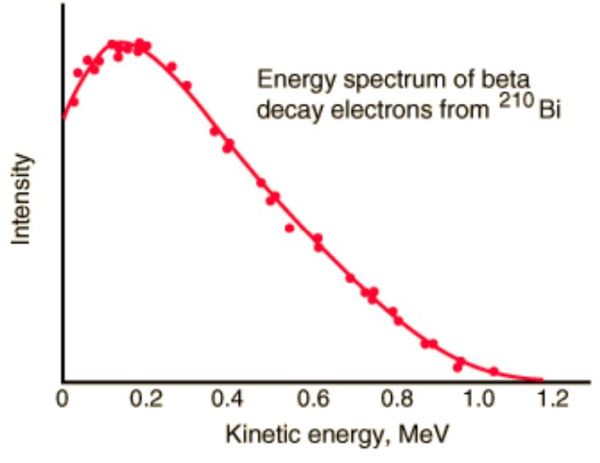Nuclear reactions
Unstable nuclei can decompose, or loose energy to become more stable. The process of of nuclear decomposition can either be spontaneous or induced.
There are two types of nuclear reaction, fission where they break apart or fusion where they join together.
Nuclear Fission
Spontaneous
The following nuclear decompositions are examples of a spontaneous processes. These processes occur because the nucleus is unstable and the nuclei
formed are more stable.
Alpha emission
Beta emission
Beta emission caused real problems when it was researched because beta particles were emitted with a spread of energies.

From G. J. Neary, Proc. Phys. Soc. (London), A175, 71 (1940).
Energy in the nucleus is quantised and as should be the energy of the beta particle. Without this quantisation basic physics like conservation of
momentum would be broken.
The solution to the problem was the prediction of a new tiny particle which is also emitted at the same time. The particle has to be neutral and tiny.
In the section on the Standard Model there is more information about this.
Gamma Emission
Induced
When neutrons collide with the nuclei of 235U they induce a nuclear reaction which causes the uranium nucleus to break apart
into smaller nuclei.
Mass Energy Conversion
The above reaction not only involves the creation of new nuclei and three neutrons, but some of the nuclear mass is converted directly into energy.
Einstein worked out the energy mass conversion equation:
E = mc2
- 235-U = 235.044 amu
- 1-n = 1.0087 amu
- 148-La = 147.961 amu
- 85-Br = 84.938 amu
- 3 × 1-n = 3.0261 amu
This leads to a mass defect of 0.1276 amu.
1 amu is equavalent to 1.66054 × 10-27 kg
Therefore 0.1276 amu = 2.1188 × 10-28 kg
This is equivalent to 1.91 × 10-11 J (using E = mc2). This is the source of the large amounts of energy from nuclear power stations.
It is also responsible for heat energy in the mantle which causes movement in the techtonic plates.
Nuclear Fusion
The combination of small nuclei to make larger ones is what occurs in the sun.
This is the proton chain reaction which results in mass loss from the protons as they use to form helium. This mass is converted to energy, and
the sun looses 1.353 × 1017 kg every year, which is converted into energy. The mass of the sun is 1.989 × 1030 kg.
The massive gravitational force provides sufficient energy for the fusion to occur. Here on earth the only way to achieve fusion is to heat up a gas to approximately 100 million Kelvin. This is approximately six times hotter than the sun's core. To do this the gas must form a plasma, where the electrons are no longer associated with the nucleus, and the ions in the plasma can be controlled by magnetic fields. Without the magnetic fields the plasma would come into contact with the walls of the reaction chamber and instantly cool down. This would stop fusion from occuring. Any uncharged particles formed like neutrinos or neutrons will just stream out of the reacton chamber, and it is the energy from the neutrons that we can collect and then use to generate electricity. Currently all fusion processes take in more energy than they generate, but if the reaction chamber conditions can be resolved there will be the possibility for unlimited clean power.